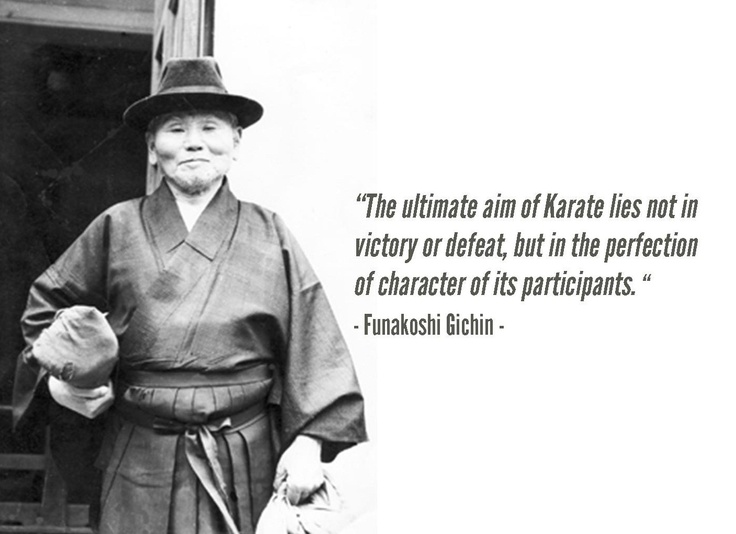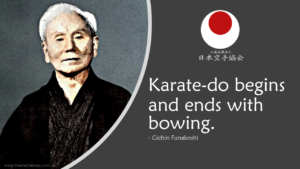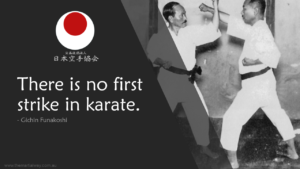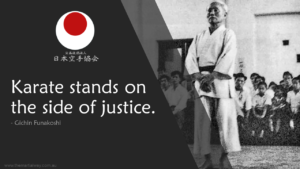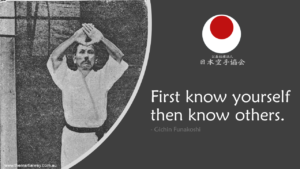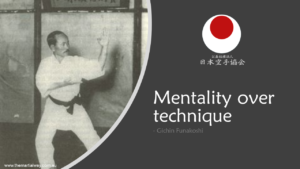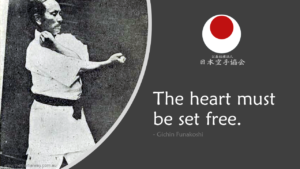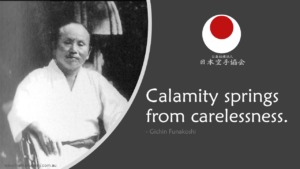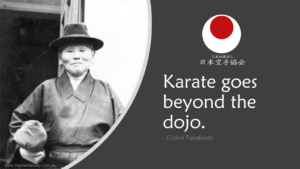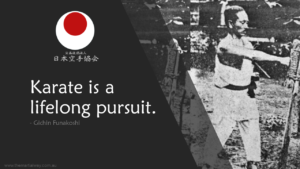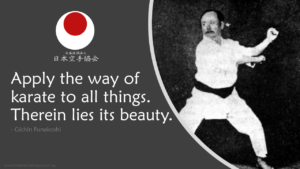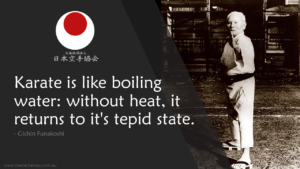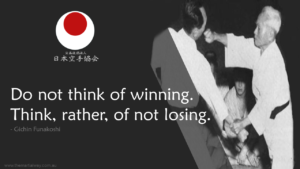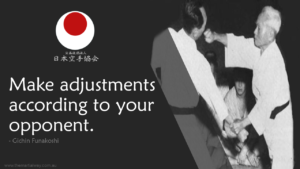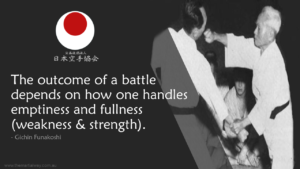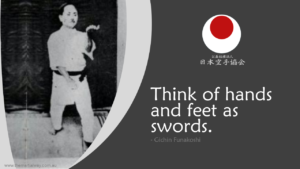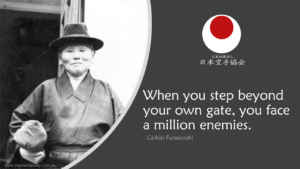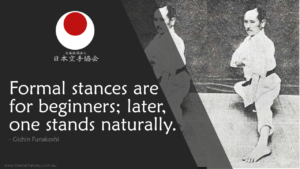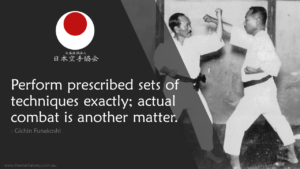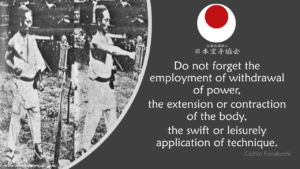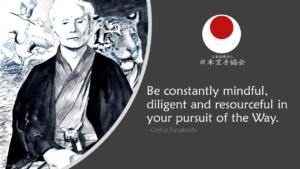Translating the Niju kun
Master Gichin Funakoshi laid out the Niju Kun (Twenty Precepts of Karate) for all Karateka's to follow. These principles form the foundations of Shōtōkan Karate-Dō. These twenty principles were based heavily on Bushido and Zen.
The principles allude to notions of respect, humility, compassion, patience, awareness and both an inward and outward calmness.
Gichin Funakoshi created both Dojo Kun 道場訓 in which you find five principles and Niju kun in which 20 more principles are described. I suspect Funakoshi wanted to make the dojo kun to cover only a few kun so that the students could recite daily. He ended up with the five most important ones. However, there were many more teachings he wanted to hand down so it became the second Kun which was originally named Karate Niju kajo 空手二十箇条 (Karate 20 principles). Now it is commonly called Niju kun 松濤館二十訓 or simply Niju kun 二十訓.
- Niju-kun 1
- Niju-kun 2
- Niju-kun 3
- Niju-kun 4
- Niju-kun 5
- Niju-kun 6
- Niju-kun 7
- Niju-kun 8
- Niju-kun 9
- Niju-kun 10
- Niju-kun 11
- Niju-kun 12
- Niju-kun 13
- Niju-kun 14
- Niju-kun 15
- Niju-kun 16
- Niju-kun 17
- Niju-kun 18
- Niju-kun 19
- Niju-kun 20
Below is the 1st part of the Niju kun:
一、空手道は礼に始まり礼に終る事を忘るな
Hitotsu, karate-do wa rei ni hajimari rei ni owaru koto o wasaru na
Karate-do begins and ends with bowing.
It is true that the word rei 礼 can be translated as bowing. So, it is true that we always start our kata with a bowing and ends with another. However, Funakoshi was trying to say something that is more comprehensive and deeper. He may have wanted to cover the general etiquette and respect by this kun. You can find another word in the 4th principle of Dojo kun, Reigi 礼儀 which means good manners. So the meaning of this kun should be understood as we must not forget that Karate-dō also means to live always with good manners whether you are inside the dojo or out.
Below is the 2nd part of the Niju kun:
一、空手に先手なし
Hitotsu, karate ni sente nashi
There is no first strike in karate.
It is commonly translated as “There is no first strike in karate.” but the meaning of this kun is much deeper. Funakoshi did not literally mean that we must not throw the first strike. What Funakoshi meant was that we will not instigate or cause a fight. But once it becomes obvious or clear that we must defend ourselves, we must do what is absolutely necessary including striking first. In Okinawa there is another popular saying, “Sente hissho” which means a first attack always brings a victory.
Below is the 3rd part of the Niju kun:
一、空手は義の補け
Hitotsu, karate wa, gi no tasuke
Karate stands on the side of justice.
Above translation makes the true meaning unclear. Gi 義 means righteousness or justice. Tasuke 補け means to supplement or supply. So, this means by practicing karate we must always abide by the laws or do what is right.
Below is the 4th part of the Niju kun:
一、先づ自己を知れ而して他を知れ
Hitotsu, mazu onore o shire, shikashite ta o shire
First know yourself, then know others.
Funakoshi was an educated person so he knew about Sun Tzu 孫子and his famous book, The Art of War. In it Sun said “If you know the enemy and know yourself you need not fear the results of a hundred battles.” There are two interesting points here. One is Funakoshi said “FIRST know yourself” while Sun listed the enemy first. This is extremely important as it comes from the Bushido philosophy. Another interesting point is that Funakoshi said to know “others” instead of the enemy. Funakoshi’s teaching was more comprehensive and could be applied to daily life both in peace and war or battle. Not stating that Sun’s teaching is less valuable, only that Sun’s idea focused only with war.
Below is the 5th part of the Niju kun:
一、技術より心術
Hitotsu, gijitsu yori shinjitsu
Mentality over technique.
This translation needs further explanation to understand the deep meaning of this kun. Gijutsu 技術 means technique but gi 技 itself means technique and jutsu 術 means art, way, method and means. Therefore it means technical method or technical way. It does not necessarily mean karate techniques. When we say “gijutsu sha” or gijutsu person we mean engineer and craftsman. Regardless, Funakoshi meant the karate techniques by gijutsu. Then what is shinjutsu 心術? Shin means heart, mind and intelligence. So, we may quickly translate shinjutsu as mind way or intelligent way, however, this translation is not exactly what Funakoshi really wanted to mean. The Japanese word shin 心 has many meanings and it is a very important word for Japanese. Shin can mean center or core (kan 幹) and even stomach or guts (hara 腹). Samurai considered shin and hara to be the center of their samurai spirit or value. This is why they cut the belly when they committed seppuku or harakiri to show that their center is pure. I do not think Funakoshi was thinking of harakiri but he was thinking of the samurai spirit. Funakoshi was thinking of Gojo no toku 五常の徳 which is the five virtues of Confucian. Those virtues are Jin 仁 (benevolence), Gi 義 (justice), Rei 礼 (courtesy), Chi 智 (wisdom), Shin 信 (trust).
In short, Funakoshi put the essence in the Dojo Kun he created. He did not deny the needs for karate training but he wanted to emphasise the importance of the mental and spiritual or ethical part of self-development. He put the concept in a very short sentence and suspect he spent a lot of time with the students explaining what he really meant by this kun.
Below is the 6th part of the Niju kun:
一、心は放たん事を要す
Hitotsu, kokoro wa hanatan koto o yosu
The heart must be set free.
Interestingly the same kanji 心 is used here. The direct translation of “The heart must be set free.” does not make sense to most of the readers. As you can see the pronunciation of the kanji is different in this kun and it is kokoro. Even though the literal translation of kokoro is heart, Funakoshi meant something deeper. It is closer to the meaning of psychological mind. In other words, he was stating that we tend to get trapped in one way and do not see the other options or methods. To practice and to improve in karate we must not be trapped in one way or one method. One good example may be a bunkai. You may believe one bunkai is correct but you need to open your mind and consider other options. Funakoshi wanted us to be flexible with our mind and thinking.
Below is the 7th part of the Niju kun:
一、禍は懈怠に生ず
Hitotsu, wazawai wa ketai ni seizu
Calamity springs from carelessness.
First kanji wazawai 禍 is not really calamity in this context. Funakoshi meant rather a smaller problem or an accident. The next word ketai 懈怠 is a difficult one and it means to be lazy or to slack off. Funakoshi wanted to warn us that if we slack off from our training and whatever in our life it may result in an accident or a problem. Funakoshi is telling us to pay 100% concentration and dedication to karate training.
Below is the 8th part of the Niju kun:
一、道場のみの空手と思ふな
Hitotsu, dojo nomino karate to omou na
Karate goes beyond the dojo.
The translation here can be expanded a little though most of the readers understand what this kun means. Some may misunderstand that the meaning of this kun is limited only to the self-defence and danger outside of the dojo. Of course, it is included but his kun covers much more. Funakoshi wanted to tell us that we have to apply all the virtues (mentioned above) and the self-discipline must be applied to our daily life.
Below is the 9th part of the Niju kun:
一、空手の修業は一生である
Hitotsu, karate-do no shugyo wa isssho de aru
Karate is a lifelong pursuit.
The word of shugyo 修業 needs to be explained to better understand the meaning of this kun. It means to study, learn and train. Therefore to translate this kun as “Karate training is a lifelong pursuit.” To keep this kun and lived by it one could not accept a 10th dan rank during his/her life time. This is because he/she is still pursuing the perfection of karate. We are endlessly changing and self-discovering.
Below is the 10th part of the Niju kun:
一、凡ゆるものを空手化せよ其処に妙味あり
Hitotsu, ara yuru mono o karateka seyo; sokoni myomi ari
Apply the way of karate to all things. Therein lies its beauty.
The word myomi 妙味 is a difficult one to translate. It literally means good taste, charm or profit. If you can expand the benefits of karate to your life you can really enjoy your life. For an example, Master Funakoshi was always healthy until his death at 89 years old. He said he was applying the self-defence against illness. Another example is to avoid an accident (automobile or just falling down) and there are many others. So, the translation is “beauty” but it really means “true benefit” or “enjoyment in your life”.
Below is the 11th part of the Niju kun:
一、空手は湯の如し絶えず熱度を与えざれば元の水に還る
Hitotsu, karate Wa Yu No Gotoku Taezu Netsu O Atae Zareba Motono Mizuni Kaeru
Karate is like boiling water; without heat, it returns to its tepid state.
The translation above needs no further explanation.
Below is the 12th part of the Niju kun:
一、勝つ考は持つな負けぬ考は必要
Hitotsu, katsu kangae wa motsuna; makenu kangae wa hitsuyo
Do not think of winning. Think, rather, of not losing.
In the case that you are a competitor, you may wonder whether you should fight to a draw if you are not supposed to be thinking of winning or losing. Of course Master Funakoshi was surely not thinking this as he had opposed any tournaments and competitions. So, I assume he was talking about a real fight. By this somewhat contradictory kun, Funakoshi was telling us that the ultimate aim is not to get into any fights or conflicts.
Below is the 13th part of the Niju kun:
一、敵に因って轉化せよ
Hitotsu, tekki ni yotte tenka seyo
Make adjustments according to your opponent.
Should mention teki 敵 is more than just an opponent. It means the enemy and the challenges in general. Therefore, Funakoshi was not talking about adjusting only to the people you fight but to all possible challenges you may face in your life.
Below is the 14th part of the Niju kun:
一、戦は虚実の操縦如何に在り
Hitotsu, tattakai wa kyo-jitsu no soju ikan ni ari
The outcome of a battle depends on how one handles emptiness and fullness (weakness and strength).
This kun is a challenging one to translate and what makes this kun difficult is the kanji of kyo jitsu 虚実. Let’s investigate the meaning of these two kanji letters. Kyo 虚 literally means imaginary, hollow, falsehood or fake. On the other hand jitsu 実 means the opposite including truth, reality and substance. Then another word, soju 操縦 is translated as handles which is not incorrect but the word is passive. In fact, soju is more aggressive and it means control and drive. So, it can be translated as the outcome of a battle depends on how one controls the falsehood and the reality. In a kumite situation it can be a fake technique and a real technique. However, the first kanji tatakai 戦 does not necessarily mean a battle against an enemy. Funakoshi was thinking larger. He was referring to all the battles in your life such as sickness, wealth, work, etc. When he migrated to Japan he was already 54 years old. He was a respected school teacher in Okinawa but when he moved to Tokyo he had no place to live. For many years, he had to live in a school’s very small maintenance room. He used to say with a smile on his face that he had a small bedroom but the backyard was huge. Of course, it was not a backyard but the school campus. He won the battle against poverty by controlling his mind.
Below is the 15th part of the Niju kun:
一、人の手足を剣と思へ
Hitotsu, hi to no te-ashi wa ken to omoe
Think of hands and feet as swords.
Funakoshi truly believed in this concept. You can see this from at least two things he did. One is he rejected both kata and training method of Sanchin which is a very popular kata among the Naha-te 那覇手 styles such as Goju ryu 剛柔流 and Uechi ryu 上地流. What he rejected was not the kata itself but its training method in which a sensei would hit and kick the performer to check his chinkuchi (body tension). This is the exercise to prepare the practitioner for getting punched and kicked. Funakoshi thought such an exercise or preparation was useless as he believed that the opponent’s hand and foot were swords. His concept was not to get hit at all. The other action by Funakoshi was the rejection of the tournament. He had a few reasons to oppose this. One of them was his belief that a karate technique must be improved to the point of Ikken hissatsu 一拳必殺 which means one punch certain kill. Just as you do not have a tournament with a real sword, he considered it impossible to have a tournament using karate techniques at full speed and power. Despite strong opposition by Funakoshi, JKA went ahead with the first all Japan championship in 1957. It has been more than 50 years since the introduction of large scale tournaments in Japan. Considering Funakoshi believed in the hand and foot being a sword, it is rather ironic that no one has been killed or even seriously injured in any of the major tournaments in Japan so far.
Below is the 16th part of the Niju kun:
一、男子門を出づれば百万の敵あり
Hitotsu, danshi mon o izureba hyakuman no teki ari
When you step beyond your own gate, you face a million enemies.
This is a literal translation of the Japanese kun. 百万 hyakuman means one million but it also means simply a lot. This is the same as an English phrase “Thanks a million”. So, the following translation is more appropriate, “…………., you face many enemies.”
Below is the 17th part of the Niju kun:
一、構は初心者に後は自然体
Hitotsu, kamae wa shoshinsha ni atowa shizentai
Formal stances are for beginners; later, one stands naturally.
The words “formal stances” are not clear nor accurate. We know what “kamae” 構 means and it is a fighting stance. We also know the word shizentai 自然体 and it was translated correctly. It is a natural stance. The tricky part is the translation of “atowa”. Its literal meaning is “later” but the question is how much later. It is not a few minutes or even a day later. The time span is much longer as it means when a beginner gets to be an advanced practitioner. So, the better translation may be “A fighting stance is only for the beginners, when they become advanced they should fight from the natural stance.”
Below is the 18th part of the Niju kun:
一、形は正しく実戦は別物
Hitotsu, kata wa tadashiku, jisen wa betsumono
Perform prescribed sets of techniques exactly; actual combat is another matter.
Funakoshi stated that we should do the kata correctly which means he did not want us to change or modify them. The translation for the second part is acceptable. Funakoshi wrote this kun as many university students wanted to change the katas. There was also a big difference between how you perform the katas, and the movements in bunkai. He must have spent a lot of energy explaining the reasons for the difference, however, I am afraid the students did not possess the necessary skill to understand what Funakoshi meant. Funakoshi wanted to impress on the students that the katas must be done as they were taught. This brings up a very interesting point as Funakoshi was the one who changed and modified the katas he brought from Okinawa. Funakoshi received a lot of criticism from the masters in Okinawa at that time but he believed those changes were needed. I agree with some of them though with great respect I disagree with others. One good example of my disagreement is that he switched all neko ashi dachi (Cat stance) to kokutsu dachi (Back stance). Another is his change of sanchin to hangetsu. In other words, he de-emphasised short stances and focused on the long and low stances. We can suspect that his son, Gijo had a big influence on this.
Below is the 19th part of the Niju kun:
一、力の強弱体の伸縮技の緩急を忘るな
Hitotsu, chikara no kyojaku tai no shinshuku waza no kankyu
Do not forget the employment of withdrawal of power, the extension or contraction of the body, the swift or leisurely application of technique.
We should consider this kun one of the most important from the karate training perspective. Let’s look at those three elements.
First one is chikara no kyojaku 力の強弱. Chikara is power that a practitioner executes. Kyojaku means literally strong and weak. So, Funakoshi is saying you need to know when to use power and when not to. You see this in many of the advanced katas and this must be the same in kumite. The teaching here is not to tense all the time. Probably the most difficult is to master how to change the level of power used. For instance, in mawashi uke you need to start from rather non tension (weak) to tension or strong ending. Another situation may be from a strong kime technique to the next move that is slow and without tension (ie. Heian sandan, from oi zuki/ki-ai to heisoku dachi morote koshi kamae).
The second one is tai no shinshuku 体の伸縮 tai means body and shinshuku means expansion and contraction. My sensei used to tell us to make our techniques big. I had some difficulty understanding him at that time but now I understand he wanted us to expand our body (as we were too tensed). We need to extend our arms and legs when we execute many long techniques such as oi zuki, gyaku zuki, mae geri and yoko geri. Even for the straight blocking techniques despite the blocking arm being bent, you must expand the chest or back. The students tend to contract too much and fail to expand sufficiently.
The last one is waza no kankyu 技の緩急. Waza means techniques and kankyu means fast and slow. What is important is that this fast and slow is not only described in speed but also in timing. I am afraid that Funakoshi would be crying if he could see how the katas were modified in the tournaments. Not only the techniques themselves but also the speed and timing have been altered these days. I particularly see the katas done with extremely long pauses and also without the slow tempo or timing that is necessary. We must remember that the katas were created from actual fighting experience and there is a well thought out reason in each combination and sequence.
And finally, the 20th piece of the Nuji kun:
一、常に思念工夫せよ
Hitotsu, tsune ni shinen ku fu seyo
Be constantly mindful, diligent, and resourceful, in your pursuit of the Way.
The literal translation of this kun is “Always think deep 思念 and be creative 工夫.” The above translation is much longer than what the Japanese kun says. The translator was correct by adding “in your pursuit of the Way” as this kun is also not only for the karate training but also for the pursuit of the way 道, karatedo .
Funakoshi purposely placed this kun at the very end. He was blamed by many Okinawan masters that he made many changes in not only the karate techniques such as stances but many of the cultural things that came along with karate including the names of the katas, gi or uniform, dan ranks, etc. I am sure he hesitated in making those changes but after deep consideration he made those changes because he believed they were necessary. Not to simply justify his behaviour but he felt this stance or attitude is absolutely necessary if you pursue the way of Karate-dō in your life. Funakoshi is telling us how to get to the Ha 破 stage of Shu Ha Ri 守破離. He of course meant this to apply to more than just practicing karate. He wants us to follow this path and apply it to everything in your life.

Niju kun – 20 Percepts of Shōtōkan Karate by Master Gichin Funakoshi
Translation by Shihan Kousaku Yokota. 8th Dan Shōtōkan Karate – Asai Shotokan Association International (ASAI)
